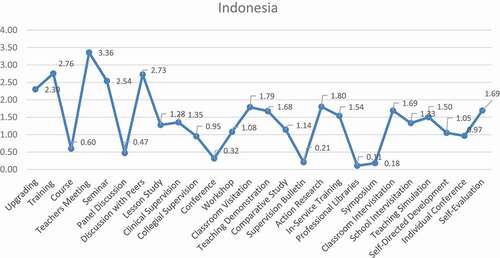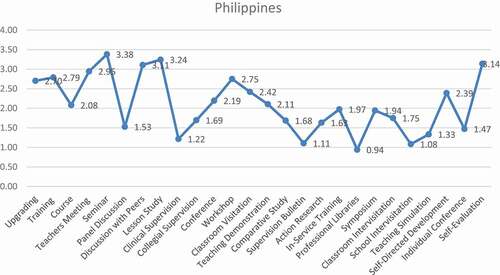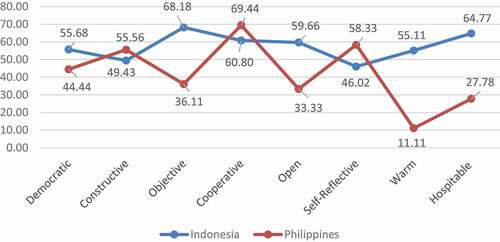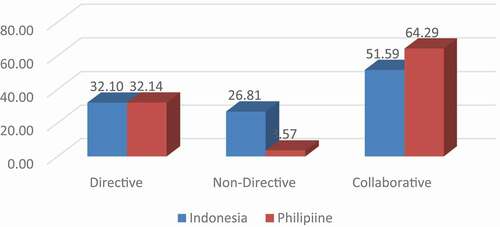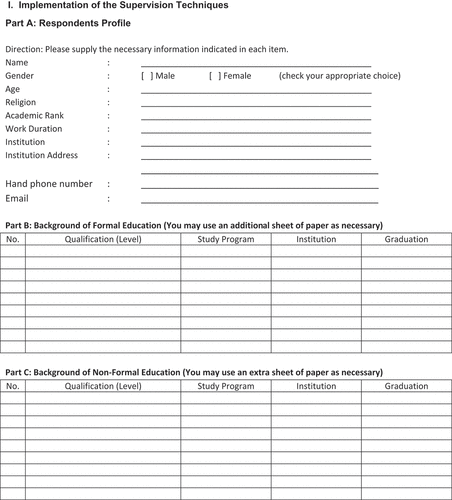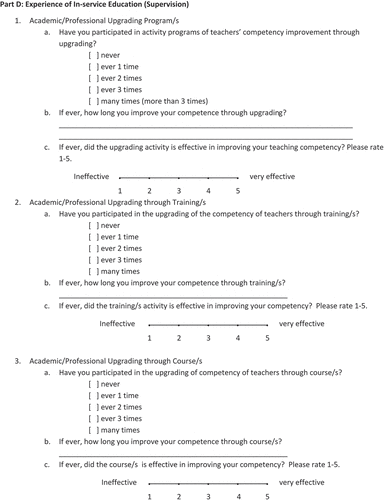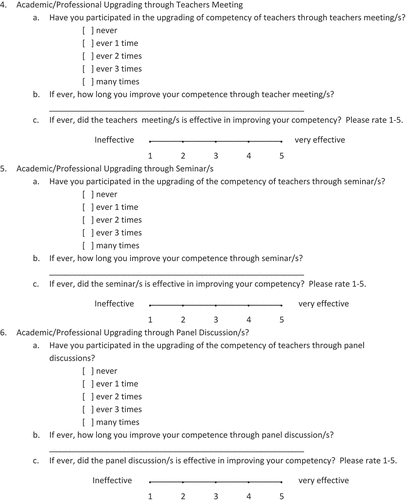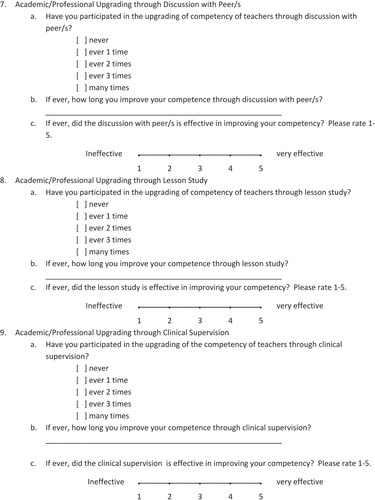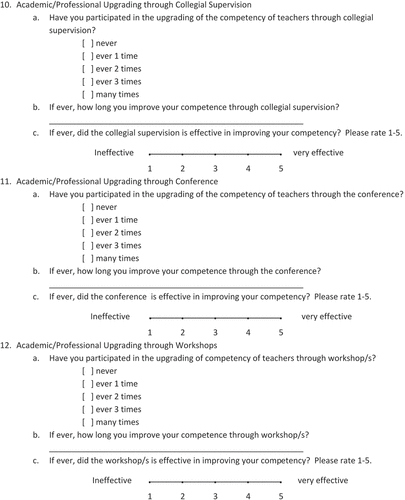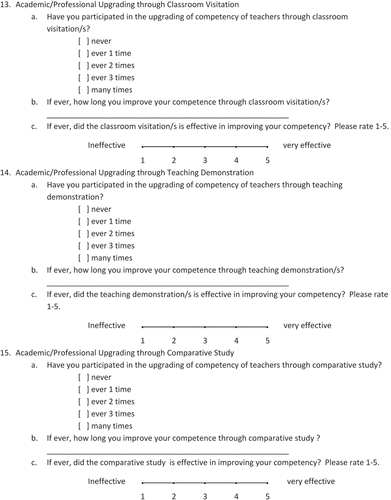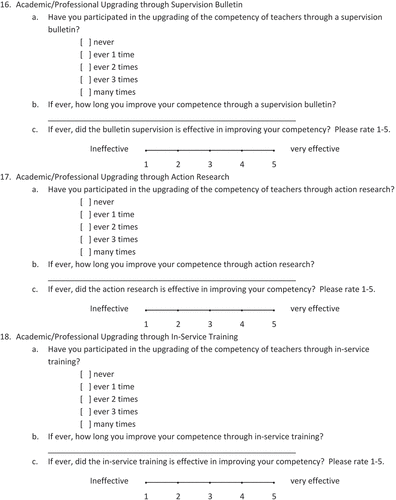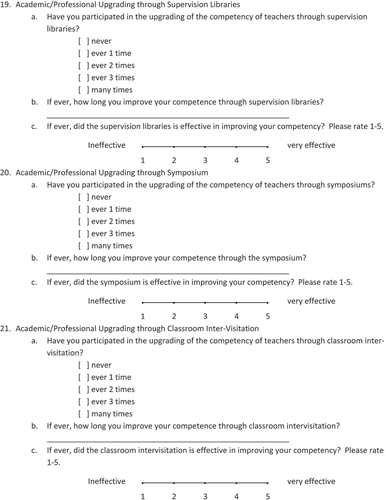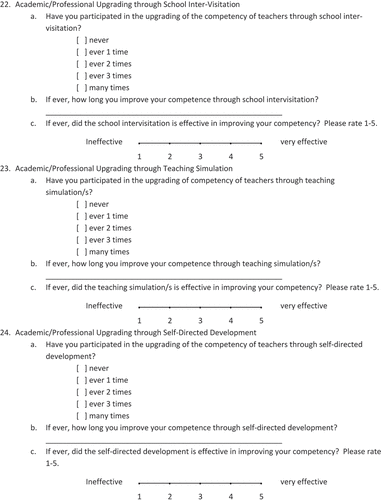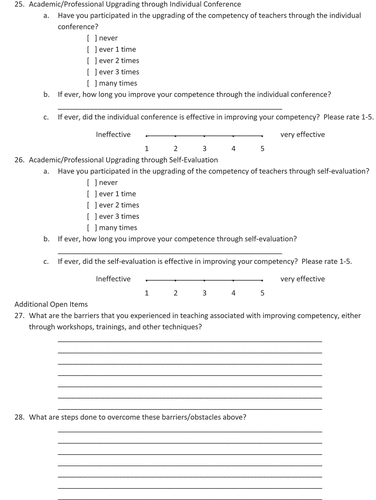Abstract
One of the most dominant variables that determines student learning outcomes is the teacher. Therefore to improve student achievement, it is necessary to improve teacher competence. The main program to improve teacher competence is instructional supervision though its effectiveness is still questionable. This study aims to describe the implementation of instructional supervision in Indonesia and the Philippines. The research design used a survey and the research sample was taken from 212 primary school teachers, divided into 176 Indonesian and 36 Filipino teachers. A questionnaire was used to collect the data, and it was then processed using descriptive statistics, t-test, correlation, and regression. The results showed that there were differences in the frequency using techniques and principles of instructional supervision both in Indonesia and in the Philippines, but there was no significant difference in their effectiveness. Of the 26 supervision techniques, the most widely used in Indonesia are teachers’ meetings, trainings, peer discussions, seminars, and upgrading programs, while in the Philippines they are seminars, lesson study, self-evaluation, peer discussions, and teacher’s meetings. On the other hand, there is a significant influence on the use of techniques, principles, and instructional supervision approaches on the variations of teacher learning models. The principle of instructional supervision has the most dominant effect on the variations of teacher learning models and materials.
PUBLIC INTEREST STATEMENT
The use of learning models and materials determines student achievement. Instructional supervision is a strategy to improve teachers’ competence in applying the learning models and materials. However, the implementation of the supervision and its effects on the variety of learning models and materials applied by the teacher has still been unknown so far. Based on the results of the Program of International Student Assessment, the student achievement in developing countries, including Indonesia and the Philippines, is still pretty low. Moreover, teachers’ competence also needs to be developed. Therefore, it is necessary to improve the teachers’ competence through instructional supervision. This research described the implementation of instructional supervision in both countries, explored its effect on teacher teaching competence, and found the most effective supervision to improve teachers’ competence, particularly in applying the learning models and materials in order to improve the process of learning and student learning outcomes.
1. Introduction
Education is the main element that determines the progress of the nation. Qualified human resources can only be achieved through good quality of education, and excellent resources will enhance the development of the nation. The experience of advanced countries shows that a country, even with minimal natural resources, can become a developed country because it is supported by high-quality human resources. High-quality human resources can be prepared through good education. One of the main indicators of an excellent education is that student learning outcomes can be fully achieved.
Indonesia and the Philippines are two countries that are categorized as developing countries. Based on the results of the Program for International Student Assessment (PISA) in 2018, Indonesia was in the 73rd, while the Philippines was in the 78 th out of 79 countries participating in that event (OECD, Citation2019). Thus, the learning outcomes achieved by students for Reading, Mathematics, and Science are considered low. It shows that the quality of education in Indonesia and the Philippines is still below standard.
In addition, learning is a system. The success of transforming input into the most favorable output depends on the components of the learning system. One of the components that determines student learning outcomes is the teacher. The results of the research by Rahayu et al. (Citation2018) showed that professional competence had a significant effect on the effectiveness of education in schools. Then, the research by Suryadarma et al. (Citation2007) proved that there was a negative correlation between teacher absence and student achievement. The role of the teacher is very important to achieve student achievement. The research results of Sirait (Citation2016) showed that teacher’s quality affected student academic achievement. In line with the previous study, the research results by Clotfelter et al. (Citation2007) also presented that teacher experience and competence affected student academic achievement. The research results of Kam and Imt (Citation2005) showed that the learning communication interaction between students and teachers was the most dominant predictor of learners’ perceived learning achievement. Furthermore, the study by Fischer and Hanze (Citation2019) proved that teaching methods and students’ participation during their learning process affected cognitive engagement, interest, learning achievement, and the development of student academic competence. The results of Canales and Maldonado’s research (Canales & Maldonado, Citation2018) showed that teacher characteristics had a significant effect on student achievement in Language and Mathematics. To conclude, some of the research results show that the teacher is the main component that determines student learning outcomes. Therefore, to improve student achievement, it is necessary to improve teacher competence.
The best way to improve teacher’s teaching competence is through instructional supervision which is the process of assisting teachers to develop and improve the quality of the teaching and learning process and environment, with the ultimate goal of improving student learning outcomes. To achieve the goal, the process of supervision activities needs to be carried out following the right principles and techniques. However, in reality, instructional supervision activities have not been proven yet to improve the quality of learning. The research results of Wiyono et al. (Citation2017a) showed that of the 26 instructional supervision techniques that were applied, only six techniques showed a significant influence on teacher performance. Therefore, it needs to be studied more deeply how instructional supervision activities are carried out both in Indonesia and in the Philippines. By knowing this, it is hoped that it can improve the quality of the teacher’s learning process, and in the end, it can improve student learning outcomes.
2. Literature review
2.1. Instructional supervision
Instructional supervision is the process of assisting teachers in the form of guidance, direction, stimulation, or other development activities to develop and improve the teaching and learning process and situation for a better one (Archibong, Citation2012). What is more, it is a type of in-service education to improve teacher competence. The process of implementing instructional supervision can be carried out using various supervision techniques. In terms of the number of teachers being supervised, it can be divided into two, namely group supervision and individual supervision techniques. Group supervision techniques are applied when there is a large number of teachers who are involved through trainings, workshops, upgrading programs, teacher meetings, and others; while individual supervision develops a teacher individually. Some examples of this technique are self-evaluation, self-reflection, independent development, and so on. From the communication side, it can also be divided into two, namely direct and indirect techniques. Direct technique is a process of supervision between teachers and supervisors communicating directly through teacher’s meetings, workshops, and trainings. Indirect technique is a process of supervision activities using communication media; for example supervision bulletin, job libraries, and many more.
Looking back from the approaches used, supervision can also be carried out using several methods. Glickman et al. (Citation2007) classified it into three, namely directive, non-directive, and collaborative. The directive approach is carried out if during the process of implementing supervision the supervisor is more dominant in providing direction, guidance, or other development assistance. On the other hand, a non-directive approach is applied when the teacher being supervised finds solutions to the problems faced, improves, or develops himself and the supervisor only provides motivation and supports. A collaborative approach is implemented when both supervisor and teacher actively participate in improving and developing.
In the process of implementing supervision, it is necessary to refer to certain principles. These principles include constructive, democratic, creative, innovative, objective, professional, and purposeful. Supervisors in carrying out supervision need to adhere to these principles. Supervisors should not only find errors, but they also have to provide a lot of supports to improve or increase teacher competence.
The instructional supervision program is the best way of increasing teacher competence, both in Indonesia and in the Philippines. Through the Regulation of the Minister of Utilization and State Apparatus and Bureaucratic Reform Number 16 of 2009, one of the main tasks of teachers is to develop their skills sustainably. The main activity for developing teacher teaching competencies is carried out through instructional supervision.
These activities have not been fully achieved according to the results of several studies that show different findings. The research results by Wiyono et al. (Citation2017a) showed that only 26% of supervision techniques affected teacher performance. The results of further research that were reviewed from school principal development activities also proved that only 35.3% of principal supervision techniques affected educational output in schools, far below the quality of other school management substances (Wiyono & Burhanuddin, Citation2020). In line with the previous research, the results of Sahbaz’s (Citation2011) study also showed that the in-service training program, which was a supervision technique, did not show a significant effect on the performance of the counselor. On the other hand, the results of Yavuz’s (Citation2010) study indicated that the supervision carried out by the principal did not meet the criteria. The study of Hoque et al. (Citation2020) also showed that as a whole, the supervisory practices were not correlated with teachers’ performance and attitude, and it was only directive supervision that was positively and significantly related to teachers’ performance and attitude. Based on these findings, it can be underlined that the instructional supervision carried out so far has not had an effective impact on improving the teacher’s quality of teaching.
In contrast, several studies showed different results. The results of research by McGregor and Gunter (Citation2001) showed that teacher professional development programs could improve teacher competence. The study by Rahman et al. (Citation2011) indicated that there was a relationship between teacher training and its effectiveness. The results of Malm’s (Citation2009) study showed that training programs improved teachers’ cognitive, emotional, and social abilities. Furthermore, the results of research by Shah et al. (Citation2011) also proved that in-service education and training programs had a significant effect on teacher performance in managing the class using various teaching methods, producing teaching aids, and teacher evaluation techniques. Somers and Sikorova (Citation2002) also found out that in-service education programs improved teacher teaching practices. Similarly, Yigit’s study (Yigit, Citation2008) showed that in-service education programs could develop teacher attitudes towards the use of technology in the teaching and learning process. The results of the study by Bechter et al. (Citation2019) also indicated that students who were taught by teachers who took training programs on student-centered learning strategies achieved better learning outcomes. In-service education and training programs are examples of instructional supervision activities.
Based on some of the results of those studies, it can be concluded that several findings indicate the instructional supervision carried out so far has an effect on the teacher’s quality of teaching though several other findings do not show a significant effect. Therefore, it needs to be examined more deeply on how the supervision process is carried out, and what aspects of the instructional supervision that affect the quality of teaching. For this reason, this research is being carried out.
2.2. Teacher learning model and materials
The teacher learning process is a process of creating an environmental system that enables student learning. The environmental system includes objectives, materials, types of activities carried out, and available facilities. What is more, the learning process is an activity to organize and arrange the environment around students, so that it can encourage and foster students to participate actively during the learning activities.
Teachers can use a variety of models, methods, media/aids, and learning materials in the learning process. Learning itself is seen as an activity to remember, understand, explain, analyze, synthesize, think, participate, and implement. Learning is a transformation in the student’s personality that integrates as a new pattern of skills, attitudes, habits, intelligence, and abilities. By applying a variety of teacher learning models and materials, it can encourage students to take part actively in various learning activities, so that they can maximize the learning outcomes.
The teacher learning model affects student learning outcomes. The research results by Cakir (Citation2017) showed that the 5E learning model (Engage, Explore, Explain, Elaborate, and Evaluate) affected students’ academic achievement, attitudes toward science, and processing skills. The research results by Nurlaela et al. (Citation2018) indicated that thematic learning models were more effective in accommodating students’ learning styles and reading skills. The results of the research by Rasyad et al. (Citation2019) showed that besides the quality of input, of the six components of the learning system, the quality of instructors and training materials had a dominant effect on training outcomes.
Based on some of the research results previously, it can be concluded that the teacher learning model and learning materials affect student learning outcomes. The more various learning models and learning materials are, the more active students participate during the class. Furthermore, the more active students participate during the learning process, the better learning outcomes will be achieved. Hence, to improve student learning outcomes, it is necessary to increase the variety of teacher learning models and materials. A variety of models and learning materials that emphasize active participation and interaction during the process of learning, will improve the student learning outcomes. Therefore, it needs to be linked to the instructional supervision activities whether they affect the ability of teachers in using various learning models and materials and it has become a question. For that reason, this research is very important and necessary to carry out.
In terms of duties, both in Indonesia and in the Philippines, some efforts have to be done to develop themselves which are the main task of teachers. In Indonesia, it is known as sustainable professional development which is the third element of the teachers’ main task, while in the Philippines it is known as personal growth and professional development which is the domain of 6 teacher’s standard competencies (Gepila, Citation2020). Supervision of learning is the main dimension task that must be carried out by school principals and school supervisors to improve teachers’ abilities in learning. Participating in learning supervision activities, both individually and in groups, is part of teacher professional development activities. How it is implemented in schools needs to be studied more deeply.
2.3. Research hypothesis
Based on the background, the purpose of this study is to describe the techniques, principles, and approaches of supervision implemented in Indonesia and the Philippines, and to examine their effects on the teacher learning or teaching models and materials. The main objective of this research is not to compare it in two countries but to describe the implementation of instructional supervision in both countries and determined its effect on variations of teaching models and materials of teachers. The formulation of the hypothesis proposed is: (a) there is a significant effect of the application of instructional supervision techniques on the variations in the teacher learning models and materials, (b) there is a significant effect of the instructional supervision principles on the variations in the teacher models and materials, and (c) there is a significant effect of the instructional supervision approaches on the variations in the teacher learning models and materials. Through this research, it is expected that comprehensive findings will be obtained to improve the quality of the learning process and student learning outcomes.
3. Methods
3.1. Research design and participants
This research was conducted in two countries, namely Indonesia and the Philippines. The research design used a survey research design. The study of the population was primary education teachers in both countries. From all cities in Indonesia, Malang was taken as the research sample, while from the Philippines, Marawi City was taken as the research sample. Malang is an education city with a population of 8,264 teachers. 176 teachers (2.13%) were chosen as the research sample using the cluster random sampling technique. Marawi city is also a city of education with a population of 1,730 teachers and 36 teachers (2.08%) who were selected as the research sample. Cluster random sampling was also used as the sampling technique.
Primary education teachers were chosen because it serves as the foundation for the student’s personal development to become good citizens, the foundation for student’s basic abilities, and early education in preparation for higher education. The main abilities given to students are basic skills that enable students to think critically, imaginatively, and innovatively, which are needed in this digital era. By improving the quality of learning in primary education, it will be able to improve the quality of education at the next level.
3.2. Research instruments
Moreover, a questionnaire was used as the data collection technique. The research instruments were developed based on the research variables. The instrument for measuring the implementation of learning supervision was developed based on the theory of learning supervision and conditions in the field. For example, to identify the supervision approach, Glickman’s developmental supervision theory is used, which divides it into three, namely directive, non-directive and collaborative supervision approaches (Glickman et al., Citation2007). Likewise, techniques and principles of supervision are developed based on the instructional supervision techniques and the principle theory from Gwynn, Sergiovanni, Starratt, Gordon, Beinart and Clohessy (Citation2017), or other supervision experts by considering conditions in reality. The instrument for measuring the learning model was developed according to the theory of innovative learning models based on constructivist psychology, namely cooperative learning, individual learning, problem-based learning, project-based learning, problem posing, performance based-learning, and contextual teaching-learning. Meanwhile, material variations are also developed based on the appropriate learning sources, whether they are visual, audio, printed, or other sources.
A total of 26 items were used to explore the frequency of supervision and its effectiveness, 8 items to find out the data of the principles of the supervision, 3 items to search for the data of the supervision approach, 7 items to explore the data of learning models, and 4 items to reveal the data about learning materials. The form of the instrument used was the rating scale, equipped with open-ended questions. The frequency of the implementation technique was that there were five scores for the given answer choices, namely 0 = never, 1 = once, 2 = twice, 3 = three times, and 4 = more than three times. Whereas, the effectiveness of the technique implementation provided five alternative answers, namely 1 = ineffective, 2 = less effective, 3 = sufficient, 4 = effective, and 5 = very effective. Besides, the supervision principles and approaches, learning models, and materials were provided in checklist forms. Open answers were also analyzed according to those criteria.
To obtain good content validity, the instrument items were developed based on the construct variables. In addition, experts’ judgments from both countries were also conducted. The instruments were developed by researchers from both countries together, and the content validation was also conducted by experts from both countries. The instrument was reviewed in-depth, revised, and refined, so that good face validity can be obtained. The results of the item analysis using the sign test of profile patter didn’t indicate different responses from the experts of the two countries as well. The sample of the instrument was attached in the appendix. To obtain empirical validity, instrument trials were conducted. The validity of the instrument was tested through item-total analysis, while the reliability of the instrument was analyzed using the Cronbach Alpha formula. The results of the instruments analysis were presented in .
Table 1. Results of validity and reliability analysis of the instruments
Based on , it is known that the results of the grain-total analysis showed a coefficient of r > 0.3, and significance for each item was obtained. Thus, it can be concluded that the instrument had good item validity. Then, the results of Cronbach Alpha reliability analysis also indicated that the reliability coefficient of the instruments was greater than 0.7, and 0.55, so it could be concluded that the instruments had good reliability, and could be used to collect the data (Johnson & Christensen, Citation2004; Martens, Citation2010).
3.3. Data analysis
To process the research data, two data analysis techniques were used, descriptive and inferential statistics. Descriptive statistics were used to describe the data, while inferential statistics were used to test the hypotheses. Some of the descriptive data analysis techniques used were mean, frequency distribution, percentage, and graphs. Whereas, some inferential statistics used were the t-test, Pearson product-moment correlation, and regression. The dependent sample t-test was used to know differences in the implementation of instructional supervision in Indonesia and the Philippines, while the Pearson product-moment correlation and regression were used to test its effects on teachers’ learning models and materials. For the assumption analysis, the Kolmogorov Smirnoff technique was used to test the normality of the data, and Levene to test the variant homogeneity of the data (Johnson & Christensen, Citation2004; Martens, Citation2010).
4. Results
4.1. The frequency of the implementation of instructional supervision techniques in Indonesia
In general, the frequency of the implementation of supervision techniques applied in Indonesia is presented in .
Based on , it can be underlined that the instructional supervision technique that is mostly used is Teacher’s Meeting, while the least technique used is Profession Libraries. In general, the mean score was 1.4 and it is in the poor category. When viewed partially, it can be classified into five, namely (a) the most frequently implemented technique, namely the teacher’s meeting technique which was 3.85%, (b) the techniques that are often implemented, namely training, discussion with peers, and seminars which were 11.54 %, (c) 23.08% of the sufficiently implemented techniques, namely upgrading, action research, classroom visitation, self-evaluation, classroom inter-visitation, and teaching demonstration, (d) less implemented techniques, namely in-service training, teaching simulation, school inter-visitation, lesson study, comparative study, workshops, self-directed development, which was 38.46%, and (e) less applied techniques, namely courses, panel discussions, conferences, supervision bulletin, symposiums, and supervision libraries which was 23.08%.
While the implementation of instructional supervision techniques carried out in the Philippines is broadly presented in .
Based on , it can be underlined that the instructional supervision technique that was mostly used was seminars, while the least applied was professional libraries. The overall mean score was 2.1 which can be concluded in the sufficient category. When viewed partially, it can be classified into five, namely (a) the most often implemented techniques, namely seminars and lesson studies were at 7.69%, (b) often implemented techniques, namely self-evaluation, discussion with peers, teacher’s meetings, training, workshops, upgrading and classroom visitation, which were 26.92%, (c) sufficient implemented techniques, namely self-directed development, teaching demonstration, courses, in-service training, symposia, classroom inter-visitation, collegial supervision, comparative study, and action research, which were 38, 46%, (d) the techniques were not implemented, namely panel discussion, individual conference, teaching simulation, clinical supervision, supervision bulletin, school inter-visitation, and profession libraries were at 26.92%.
According to , it can be concluded that there has been no high difference in the frequency of the supervision techniques applied in Indonesia and the Philippines. In general, the frequency of the supervision techniques used in the Philippines is higher than in Indonesia. It can be proven from the results of the t-test, which was obtained at −5.057, with a p-value < 0.01 which means that there is a significant difference in the frequency of the instructional supervision techniques. The techniques that are often applied in Indonesia are teacher’s meetings, trainings, discussion with peers, seminars, and upgrading programs; while in the Philippines the most frequently applied are seminars, lesson study, self-evaluation, discussion with peers, and teacher’s meetings. The least applied techniques used in Indonesia are courses, panel discussions, conferences, supervision bulletin, symposiums, and supervision libraries; whereas in the Philippines the least applied techniques used are individual conference, teaching simulation, clinical supervision, supervision bulletin, school intervisitation, and profession libraries.
4.2. The effectiveness of instructional supervision techniques
The second problem formulation that is expected to be found in this study is to describe the effectiveness of instructional supervision techniques implemented in Indonesia and the Philippines. Broadly speaking, descriptions of the effectiveness of instructional supervision techniques in the two countries are presented in .
Based on , it can be underlined that many instructional supervision techniques have a score close to 4. This shows that the supervision techniques used so far are quite effective according to the teachers’ perception. The average educational supervision technique effectiveness in Indonesia was 3,925, while in the Philippines it was 3,917. When tested with the different analysis techniques, the t coefficient value was 0.101, with a p-value = 920. The p-value was above 0.05, thus, it could be concluded that there was no difference in the technical effectiveness of the applied instructional supervision.
When viewed from the average level of effectiveness, it was perceived by teachers, there are supervision techniques that show a very high level of effectiveness, and there are several techniques that show sufficient effectiveness. Several techniques showing a very high average of effectiveness are as follows: teachers’ meetings, discussion with peers, action research, in-service training, symposia, classroom inter-visitation, school inter-visitation, and self-evaluation. Some of the techniques that show a fairly moderate average of effectiveness are clinical supervision, conferences, workshops, classroom visitation, teaching demonstration, supervision bulletin, and professional libraries.
When examining the effectiveness of each technique according to teacher assessments in Indonesia and the Philippines, it appears that several techniques show almost the same effectiveness level, and several other techniques tend to show different results. Techniques that tend to show almost the same effectiveness level are upgrading, discussion with peers, supervision bulletin, action research, in-service training, school inter-visitation, self-directed development, and individual conferences. Some of the techniques that tend to be different are seminars, lesson study, clinical supervision, conferences, classroom visitations, teaching demonstrations, professional libraries, and symposiums. For example, classroom visitation, teaching demonstration, and clinical supervision in Indonesia are categorized as very effective, while in the Philippines they are categorized as quite effective. On the other hand, technical seminars, lesson studies, conferences, professional libraries, and symposiums in Indonesia tend to be quite effective, while in the Philippines they are categorized as very effective.
4.3. The implementation of instructional supervision principles and approaches
Based on the results of the analysis, the implementation of instructional supervision generally refers to the principle of instructional supervision. The average score of the application of the principle of instructional supervision in Indonesia was 57.46, while in the Philippines the average score was 42.01. Overall, the average obtained was 49.74, so it is still quite low, which is below 50%. The application of the principle of instructional supervision in Indonesia is higher than in the Philippines. This is confirmed by the results of the difference analysis, the t value is 2.159 with a p-value < 0.05. There are significant differences in the use of instructional supervision principles in Indonesia and the Philippines. The differences viewed from each principle can be presented in .
Based on , it appears that when viewed individually, there are differences in the emphasis of the instructional supervision principles applied. For example in Indonesia, there is more emphasis on the principles of objective, hospitality, cooperative, open, warm, and democratic. Meanwhile, supervisions in the Philippines emphasize cooperative, constructive, self-reflective, and democratic principles. In terms of the instructional supervision approach used, the outline is presented in .
Based on , it can be concluded that both Indonesia and the Philippines use more collaborative approaches, followed by the directive approach in the second place, and finally the non-directive approach in the third place. The difference is that the non-directive approach in Indonesia is still pretty high, but in the Philippines, it is very low.
4.4. The influence of the frequency of techniques, principles, and instructional supervision approaches to the variation of teacher learning models and materials
The second research objective is to examine the effect of instructional supervision followed by the teacher on the variety of learning models and materials that they implement. The formulation of the tested hypothesis was that there was a significant positive effect on the application of the techniques and supervision principles on the variation of models and teacher learning materials. For that, it is necessary to look at the results of the analysis of zero-order correlation, multiple correlation and regression, and partial correlation. The results of the zero-order correlation analysis are presented in .
Table 2. Correlation of Zero-Order Frequency Techniques and Instructional Supervision Principles with Teachers’ Learning Models and Materials
Based on , it can be seen that the results of the zero-order correlation analysis show that the frequency of instructional supervision techniques has a significant effect only on variations in teacher learning models, while variations in the use of learning resources are not significant. Conversely, the application of the principle of instructional supervision has a significant effect both on variations in teacher learning models and variations in teacher learning materials.
The results of the simultaneous analysis, the effect of the frequency of techniques, and principles of instructional supervision on teachers’ variations of learning models are presented in .
Table 3. Simultaneous Influence of the Frequency of Techniques and the Principles of Instructional Supervision on Teachers’ Learning Models
Based on , it can be concluded that there is a simultaneously significant influence on the frequency of techniques and instructional supervision principles on variations in teacher learning models, with a multiple correlation coefficient of 0.520 and a determinant of 0.271. The results of the partial analysis show the effect of each variable, namely the variable frequency of instructional supervision techniques, obtained a partial r coefficient of 0.181, and a beta of 0.161, with p < 0.05, while the variable principle of instructional supervision obtained a partial r of 0.466, and a beta of 0.461, p-value <0.05. This means that there is a significant influence of the frequency variable of instructional supervision techniques on the teacher learning model, with a contribution of 18.1%. Moreover, there is a significant influence of the instructional supervision principle variable on the teacher learning model with a contribution of 46.6%. The instructional supervision principle variable was higher than the frequency variable of instructional supervision techniques.
The results of the simultaneous analysis, the effect of the frequency of techniques, and the principles of instructional supervision on variations in teacher learning materials are presented in .
Table 4. Simultaneous Effect of Technique Frequency and Instructional Supervision Principles on Teachers’ Learning Materials
Based on , it can be concluded that simultaneously there is a significant influence on the frequency of techniques and instructional supervision principles on variations in teacher learning materials, with a multiple correlation coefficient of 0.346 and a determinant of 0.120. The results of the partial analysis showed the effect of each variable, namely the variable frequency of instructional supervision techniques, obtained a partial r coefficient of 0.006, and a beta of 0.078, with p > 0.05, while the variable of instructional supervision principles obtained a partial r of 0.345, and a beta of 0.338, with p-value <0.05. This means that there is no significant effect of the frequency variable of instructional supervision techniques on variations in teacher learning materials. There is a significant influence of the instructional supervision principle variable on the variation of teacher learning materials with a contribution of 34.5%.
The effect of the instructional supervision approach on variations in teacher learning models and materials can be seen from the results of the correlation analysis of each instructional supervision approach to variations in teacher learning models and materials. The formulation of the hypothesis that was tested was that there was a significant effect of the use of the instructional supervision approach on the variation of models and teacher learning materials. The results of the zero-order correlation analysis are presented in .
Table 5. Correlation of Zero-Order Instructional Supervision Approach with Teachers’ Learning Models and Materials
Based on , it can be underlined that the directive, non-directive, and collaborative approaches have a positive effect on the variety of teacher learning models. However, only the collaborative approach affects variations in teacher learning. The directive and non-directive approaches do not have a significant correlation with variations in teacher learning materials. Therefore, it can be concluded that the two approaches do not affect variations in teacher learning materials.
5. Discussion
Based on the results of the data analysis, it shows that several instructional supervision techniques tend to be done a lot and some are lacking in Indonesia and the Philippines in improving teacher teaching abilities. Some of the techniques that are widely practiced, both in Indonesia and in the Philippines, are teacher meetings, seminars, discussion with peers, and upgrading. Some of the underutilized techniques, both in Indonesia and the Philippines, are panel discussions, supervision bulletin, and professional libraries. Some of the techniques used in both countries are classroom inter-visitation, clinical supervision, action research, teaching simulation, and school inter-visitation. Some of the techniques that are less used in Indonesia, but are highly applied in the Philippines are lesson study, conference, and symposium.
From these findings, it can be underlined that there was more emphasis on group supervision in the two countries. The five most widely used instructional supervision techniques are group instructional supervision. When viewed from the communication media used, both countries emphasize direct instructional supervision techniques, namely face-to-face between supervisors and supervisees. Two instructional supervision techniques that are less used are also indirect supervision techniques, namely supervision bulletin, and professional libraries. When viewed from the supervisors’ side, the most instructional supervision techniques used are those of a collegial nature. Three of the four most widely used instructional supervision techniques are collegial supervision techniques. This is confirmed by the results of the supervision approach analysis that showed the emphasis on the collaborative supervision approach. The results of this study are in line with the results of research by Wiyono and Kusmintardjo (Citation2017a) which show that the instructional supervision techniques that are most widely applied in teacher coaching are group techniques. The research results of Wiyono et al. (Citation2019) further show that direct and group techniques are used by many principals in establishing relationships with the parents. Therefore, in carrying out instructional supervision of teachers, many principals also tend to use group techniques and a direct approach.
Other descriptive findings indicate that both Indonesia and the Philippines have tended to use the right principles, but they are still relatively low. Indonesia has a higher use of the principle of supervision compared to the Philippines and there are differences in principle emphasis. In Indonesia, the emphasis is on democratic, objective, cooperative, open, warm, and hospitable principles, while the Philippines emphasizes more constructive, cooperative, and self-reflective principles. This is related to the cultural background of each country, as Indonesia tends to have democratic, cooperative, warm, and hospitality cultures, and the Philippines places more emphasis on cooperative, constructive, and self-reflective cultures. This finding is in line with the results of research by Samawi et al. (Citation2019) which found that instructional supervision that is appropriate to be applied in Indonesia, especially in early childhood education, is culture-based instructional supervision, which refers to the principles of openness, collaboration, empowerment, cooperation, democracy, and religion.
The findings of further research indicate that there is an effect of the frequency of techniques, principles, and instructional supervision approaches on variations in teacher learning models, with only the use of instructional supervision principles that has a significant effect on variations in teacher learning materials. This shows that the use of instructional supervision principles has a higher effect than the application of instructional supervision techniques and approaches. These three variables affect the teaching performance of teachers, but the highest in the application of the principle of instructional supervision.
These findings are in line with several research results. The results of research by Shakuna et al. (Citation2016) or Maisyaroh et al. (Citation2017) showed that there is a relationship between educational supervision and teachers’ performance or their teaching skills. The results of Lopez’s (Citation2016) research showed that classroom supervision is a tool to improve teacher teaching effectiveness. The results of research by Veloo et al. (Citation2013) indicated that clinical supervision can improve the teaching and learning process and students’ comprehension. The results of research by Wiyono et al. (Citation2015) showed that supervision that emphasizes teachers’ active participation, collaboration and based on humanistic principles affect teacher performance. The research results of Alfian et al. (Citation2019) also showed that the clinical approach-based supervision model that refers to the correct supervision principles affects the managerial competence of school principals. The research results of Rasyad et al. (Citation2020) also showed that the implementation of the workshop program can improve the competence of facilitators. The research results of Wiyono and Triwiyanto (Citation2018) indicated that workshop activities such as compiling lesson plans, making learning media, teaching demonstrations, delivering materials, and discussions in teacher working group meetings have an effect on teacher professionalism. The other research results of Wiyono (Citation2018) presented that self-evaluation can improve the principal’s transformational leadership, work motivation and teacher teamwork effectiveness, and school improvement. Workshops, teaching demonstrations, and discussions are group supervision techniques, whereas self-evaluation is an individual supervision technique. Furthermore, the results of research by Comighud et al. (Citation2020) also showed that instructional supervision is perceived as high in improving teacher performance in terms of goals and instructional supervision planning, but it is still relatively low in implementation and discussion after instructional supervision.
Based on the discussion of the research results, it can be concluded that the findings develop the results of previous studies that the implementation of learning supervision affects teacher teaching practices. The implementation of the learning supervision can not be seen in general, but it is examined in terms of approaches, principles, and instructional supervision techniques. Its influence is also focused on the teacher’s use of learning models and learning materials based on the constructivist learning theory. Three components of instructional supervision affect the use of teachers’ learning models and materials, but of the three components, the application of the principle of supervision has the most dominant effect on teacher’s learning models and materials. The use of learning models and materials is not only influenced by their competency factors but also motivation. The study results indicate that instructional supervision affects the competence and motivation of teachers in implementing the quality of teaching. The findings of this study are in line with the results of research by Nasreen and Shah (Citation2019) or Hoque et al. (Citation2020) which showed that instructional supervision affects teacher motivation, attitudes, and teaching performance. When studied further, the application of constructivist-based learning models, namely cooperative learning, problem-solving, and work-based learning models has a strong effect on student motivation and achievement (Damopolli et al., Citation2018; Nasution, Citation2017; Sudjimat & Permadi, Citation2019). Likewise, the enrichment of various learning materials also has a significant effect on student achievement (Oladejo et al., Citation2011; Setyowati et al., Citation2019). Through teaching supervision, the intensity of the teacher using a variety of learning models and materials will increase, and with the increasing use of these models and materials, it can ultimately improve student achievement.
Based on the findings of this study, it can be concluded that there is an effect of instructional supervision on teacher teaching performance. When viewed from the coefficient obtained, the effect is not too high, because the implementation of instructional supervision in both countries is still not optimally conducted, both in terms of techniques, principles, or the approach used. In the Philippines, the frequency of instructional supervision techniques implemented is higher than in Indonesia, but the application of the instructional supervision principle in Indonesia is higher than in the Philippines, although it is still below 60%. The results of research by Haris et al. (Citation2018) also emphasize that the implementation of instructional supervision in Indonesia needs to be improved. Supervisors need to show the right role in carrying out educational supervision. The research results of Rahabav (Citation2016) also showed that the instructional supervision carried out by the principal has so far been ineffective. Some of the causes are time problems, lack of programming, and a lack of understanding by supervisors about the concepts, theories, and practices of supervision. Therefore, it can be understood that the impact on improving teacher teaching performance is still low.
Based on the research findings discussion, it can be concluded that to improve the effectiveness of better instructional supervision, it is necessary to improve the quality of the implementation of instructional supervision carried out, as well as the techniques, principles, and approaches. To support it, the quality of school management also needs to be improved. Through the improvement of school management, it will improve the implementation of instructional supervision in schools. In the end, it will also have a higher effect on improving the quality of teaching. The research results of Citriadin et al. (Citation2019) indicated that the work environment affects teacher teaching performance. The research results by Rahayu et al. (Citation2018) also showed that teacher innovation affects teacher professional competence. Moreover, the work environment and the teacher innovation are largely determined by the management and leadership of the principal. In addition, many other research results showed that the quality of school management affects teachers’ work motivation and the quality of education in schools directly (Bafadal et al., Citation2019; Wiyono, Citation2017b).
6. Limitation of the study
Instructional supervision is the process of assisting teachers to improve teaching and learning processes and situations. The instructional supervision is aimed to improve the competencies or quality of teaching of teachers. The ultimate goal of instructional supervision is to improve the process and student learning outcomes. The improvement of teaching may refer to the improvement of teaching strategies, teaching models, teaching methods, teaching media, teaching materials, or other components of the teaching-learning system. This research only describes and tests the influence of techniques, principles, and approaches of the instructional supervision on the teaching models and materials of teachers, and not studying their effect on student achievement. The effectiveness of instructional supervision is also studied based on what teachers perceived, it hasn’t been studied in the increase of student achievement concretely. This is alimitation of this study.
Based on measurement theory, measuring the effectiveness of treatment, process, or performance can be conducted directly on the subject being treated or measured. The effectiveness of conditions rated by the teachers as the subject of the study can be a source of accurate data that indicates the actual conditions if they assess it correctly and objectively. Therefore, one of the efforts to obtain results objectively is to use a valid measurement instrument (Priestley, Citation1982; Tuckman & Harper, Citation2012). This is done in the process of this research. However, the results of treatment will be known more accurately when taken from the real results achieved. The effectiveness of instructional supervision will be obtained more clearly when the final result is shown concretely, namely, an increase in student learning outcomes. This research is limited to examining the effect of supervision on improving the quality of teacher instruction, especially in a variation of teaching models and materials. The effect is tested from the same data source so that it can indicate the correct relation or influence coefficient, but it has not yet examined its impact on student learning outcomes concretely. Therefore, these results can be taken into consideration by further researchers to conduct further research so that it can obtain comprehensive results to obtain generalizations.
7. Conclusion
Based on the research findings, it can be concluded that the frequency of instructional supervision techniques applied in Indonesia and the Philippines is still not optimal and varies from one technique to another. The instructional supervision technique that is most widely applied is the group technique and is direct. There is only a slight difference between the Philippines and Indonesia in this area. Seminars, lesson study, self-evaluation, discussion with peers, and the highest teachers meetings are held in the Philippines, while the highest teachers meeting, training, discussion with peers, seminars, and upgrading are held in Indonesia. Both countries implement supervision bulletin and professional libraries as the lowest applied instructional supervision techniques. In terms of approach, both countries tend to use the collaborative approach, and there are only slight differences in this area. In terms of principles, the two countries apply the principle of supervision, and there is only a slight difference, as Indonesia highly applies the principles of objective, hospitality, cooperative, open, democratic, and warm, while the Philippines prefers to apply the principles of cooperative, self-reflective, constructive and democratic. This is influenced by the culture of each country.
There is an influence on the frequency of techniques, principles, and instructional supervision approaches on variations in teacher learning models, but only the application of instructional supervision principles affects variations in teacher learning materials. This means that the supervision principle variable is the exogenous variable that has the most dominant influence on teacher teaching performance. The intensity in carrying out instructional supervision is very important, but what is more important than that is the use of correct principles or norms in carrying out instructional supervision. The supervisors’ behavior must reflect the professional behavior of supervisors so that it can bring about changes in the quality of teacher teaching. Instructional supervision approaches and techniques that are applied are more collaborative and direct. For this reason, the psychological foundation used emphasizes more on cognitive psychology which demands a balanced activity between supervisors and supervisees. Thus, it will be able to improve the quality of teacher learning, so that in the end it can improve the process and student learning outcomes.
Acknowledgements
The authors would like to acknowledge the support of the Faculty of Education Universitas Negeri Malang Indonesia, Mindanao State University Philipines, and Alliance of Teachers for Innovative Education, Excellence, inc.
Disclosure statement
There is no potential conflict of interest in the research.
Additional information
Funding
Notes on contributors
Maisyaroh
Maisyaroh is a Doctor in Educational Management, Faculty of Education, Universitas Negeri Malang, Indonesia. She conducted many researches and authored many books and articles for journals in the topics of educational supervision, educational management and administration, teaching and learning.
Bambang Budi Wiyono is a Full Professor in Faculty of Education, Universitas Negeri Malang. Indonesia. He conducted many researches and published articles in educational supervision and leadership.
Hardika is a Doctor in NonFormal Education, Faculty of education, and a Secretary of Instructional and Educational Development Institution, Universitas Negeri Malang, Indonesia.
Anabelie Villa Valdez is a Doctor in Science Education Biology and Educational Management, and a Professor in Mindanao State University Philippines.
Solaiman B. Mangorsi is a Doctor in Science Education and Mathematics, and
a Lecture in Mindanao State University Philippines.
Sanaorai P.T. Canapi is a Doctor in Biology MAED and Supervision and Management, and a Lecture in Mindanao State University Philippines.
References
- Alfian, W., Arifin, B. B., I., Imron, A., & Humaisi, M. S. (2019). Development of the supervision model based on clinical approach to increase managerial competence of school principal. Universal Journal of Educational Research, 7(11), 2472–30. https://doi.org/https://doi.org/10.13189/ujer.2019.071126
- Archibong, F. I. (2012). Instructional supervision in the administration of secondary education: A panacea for quality assurance. European Scientific Journal, 8(13), 61–70. file:///C:/Users/ANTONI~1/AppData/Local/Temp/197-Article%20Text-676-1-10-20120706.pdf
- Bafadal, I., Wiyono, B. B., & Sobri, A. Y. (2019). The implementation of school-based management, and its effect on the teachers’ work motivation and the school quality. Universal Journal of Educational Research, 7(9), 2021–2026. https://doi.org/https://doi.org/10.13189/ujer.2019.070925
- Bechter, B.E., Dimmock, J.A., & Jackson, B. (2019). A cluster-randomized controlled trial to improve students experiences in physical education: Results of student centered learning intervention with high school teacher. Psychology of Sport and Exercise, 45, 101553.2019/101553
- Beinart, H., Clohessy. (2017). Effective supervisory relationships, best evidence, and practice. John Wiley & Sons Ltd.
- Cakir, N. K. (2017). Effect of 5E learning model on academic achievement, attitude, and science process skills: Meta-analysis study. Journal of Education and Training Studies, 5(11), 157–170. https://doi.org/https://doi.org/10.11114/jets.v5i11.2649
- Canales, A., & Maldonado, L. (2018). Teacher quality and student achievement in Chile: Linking teachers’ contribution and observable characteristics. International Journal of Educational Development, 60, 33–50. https://doi.org/https://doi.org/10.1016/j.ijedudev.2017.09.009
- Citriadin, Y., Wiyono, B. B., Huda, M., & Arifin, I. (2019). The influences of teacher performance in public high schools in Indonesia. International Journal of Innovation, Creativity and Change, 9(6), 25–41. https://www.ijicc.net/images/vol9iss6/9602_Citriadin_E_R.pdf
- Clotfelter, C. T., Ladd, H. F., & Vigdor, J. L. (2007). Teacher credentials and student achievement: Longitudinal analysis with student fixed effects. Economics of Education Review, 26(6), 673–682. https://doi.org/https://doi.org/10.1016/j.econedurev.2007.10.002
- Comighud, S. M. T., Futalan, M. C. Z., & Cordevilla, R. P. (2020). Instructional Supervision and Performance Evaluation: A Correlation of factors. International Journal For Research In Social Science And Humanities, 6(4), 1–20. https://doi.org/http://doi.org/10.5281/zenodo.3782708
- Damopolli, I., Nunaki, J. H., & Supriyadi, G. (2018). Effect of problem-solving learning model on students achievement. Journal of Educational Research and Evaluation, 2(1), 1–9. https://ejournal.undiksha.ac.id/index.php/JERE/article/view/12558
- Fischer, E., & Hanze, M. (2019). Back from “guide on the side” to “ sage on the sage”? Effects of teacher-guided and student-activating teaching methods on student learning in higher education. International Journal of Educational Research, 95, 26–35. https://doi.org/https://doi.org/10.1016/j.ijer.2019.03.001
- Gepila J R, E. C. (2020). Assessing teachers using Philippines standards for teachers. Universal Journal of Educational Research, 8(3), 739–746. https://doi.org/https://doi.org/10.13189/ujer.2020.080302
- Glickman, D., Gordon, S. P., & Gordon, J. M. R. (2007). Supervision and instructional leadership, a developmental approach. Pearson. https://www.amazon.com/SuperVision-Instructional-Leadership-Developmental-Educational/dp/0132852136
- Haris, I., Naway., F. A., Pulukadang, W. T., Takeshita, H., & Ancho, I. V. (2018). School supervision practices in the Indonesian education system: Perspectives and challenges. Journal of Social Studies Education Research, 9(2), 366–387. https://jsser.org/index.php/jsser/article/view/268
- Hoque, K. E., Kenavathulla, H. B., Subramaniam, M. V., & Islam, R. (2020). Relationships between supervision and teachers’ performance and attitude in secondary schools in Malaysia. Sage Open, 10(2), 1–11. https://doi.org/https://doi.org/10.1177/2158244020925501
- Johnson, B., & Christensen, N. (2004). Educational research, quantitative, qualitative, and mixed approach. Pearson Education, Inc.
- Kam, M., & Imt, T. (2005). Factors of learner-instructor interaction which predict perceived learning outcomes in online learning environment. Journal of Computer Assisted Learning, 29, 292–301. https://doi.org/https://doi.org/10.1111/jcal.12005
- Lopez, M. C. A. (2016). Classroom supervisory practices and their relationship to teacher effectiveness as perceived by secondary teachers. SMCC Higher Education Research Journal, 4, 119–131. https://sherj.smccnasipit.edu.ph/articles/Vol2_April2016/Lopez.pdf
- Maisyaroh,Wiyono, B.B., Burhanuddin, & Rasyad, A. (2017). The relation of educational supervision and teachers’ teaching skills, advances in economics, 2nd International Conference on Educational Management and Administration. Business and Management Research, 45, 300–303. https://doi.org/https://doi.org/10.2991/coema-17.2017.51
- Malm, B. (2009). Towards a new professionalism: Enhancing personal and professional development in teacher education. Journal of Education for Teaching, 35(1), 77–91. https://doi.org/https://doi.org/10.1080/02607470802587160
- Martens, D. M. (2010). Research and Evaluation in Education and Psychology. Sage Publications. https://www.amazon.com/Research-Evaluation-Education-Psychology-Quantitative/dp/141297190X
- McGregor, D., & Gunter, B. (2001). Changing pedagogy of secondary science teachers: The impact of a two-year professional development programme. Teacher Development: An International Journal of Teachers’ Professional Development, 5(1), 59–74. https://doi.org/https://doi.org/10.1080/13664539700200143
- Nasreen, S., & Shah, M. (2019). Effect of Instructional supervisory practices on teacher motivation in private secondary schools of Lahore, Pakistan. Advanced in Social Sciences Research Journal, 6(11), 192–203. https://doi.org/https://doi.org/10.14738/assrj.611.7301
- Nasution, W. N. (2017). The effects of learning model and achievement motivation on natural science learning outcomes of students at state Islamic elementary schools in Medan Indonesia. Journal of Education and Training, 4(2), 131–150. https://doi.org/https://doi.org/10.5296/jet.v4i2.11144
- Nurlaela, L., Samani, M., Asto, I. G. P., & Wibawa, S. C. (2018). The effect of thematic learning model, learning style, and reading ability on the students’ learning outcomes. IOP Conferences Series: Materials Science and Engineering, 296, 1–8. https://doi.org/https://doi.org/10.1088/1757-899X/296/1/012039
- OECD. (2019). PISA 2018 results, combined executive summaries, volume I, II, III. https://www.oecd.org/pisa/Combined_Executive_Summaries_PISA_2018.pdf
- Oladejo, M. A., Olosunde, G. R., Ojebisi, A. O., & Isola, O. M. (2011). Instructional materials and students’ academic achievement in physics: Some policy implications. European Journal of Humanities and Social Sciences, 2(1), 112–126. https://www.researchgate.net/profile/Maruff-Oladejo-2/publication/265076250
- Priestley, M. (1982). Performance assessment in education and training: Alternative techniques. Educational Technology Publications. (1st US-1st Printing edition). https://www.amazon.com/Performance-Assessment-Education-Training-Alternative/dp/0877781818
- Rahabav, P. (2016). The effectiveness of academic supervision for teachers. Journal of Education and Practice, 7(9), 47–55. https://www.iiste.org/Journals/index.php/JEP/article/viewFile/29620/30413
- Rahayu, S., Ulfatin, N., Wiyono, B. B., Imron, A., & Wajdi, N. B. N. (2018). The professional competency teachers mediate the influence of teacher innovation and emotional intelligence on school security. Journal of Social Studies Education Research, 9(2), 210–227. https://jsser.org/index.php/jsser/article/view/266
- Rahman, F., Jumani, N. B., Akhter, Y., Chisti, S. H., & Ajmal, M. (2011). Relationship between training of teachers and effectiveness teaching. International Journal of Business and Social Science, 2(4), 150–160. http://ijbssnet.com/journal/index/206
- Rasyad, A., Wiyono, B. B., & Rahma, R. A. (2020). An analysis of workshop program implementation and competency improvement for adult education facilitators in Indonesia. International Journal of Innovation, Creativity and Change, 10(10), 609–623. https://www.ijicc.net/images/vol10iss10/101036_Rasyad_2020_E_R.pdf
- Rasyad, A., Wiyono, B. B., Zulkarnain, S., & Ewing, B. F. (2019). The determinant factors that influence results of gradual training of early childhood education teachers based on the program evaluation in Indonesia. Cogent Education, 6(1), 1–21. https://doi.org/https://doi.org/10.1080/2331186X.2019.1702840.
- Sahbaz, U. (2011). The effectiveness of in-service training for school counselors on the inclusion of students with disabilities. Educational Research and Reviews, 6(8), 580–585. https://doi.org/https://doi.org/10.5897/ERR.9000348
- Samawi, A., Arifin, I., Wiyono, B. B., & Imron, A. (2019). Learning supervision strengthening based on school culture in kindergarten. International Journal of Innovation, Creativity, and Change, 5(4), 1–11. https://www.ijicc.net/images/vol5iss4/5401_Samwi_2019_E_R.pdf
- Setyowati, A. J., Pali, M., & Wiyono, B. B., Triyono. (2019). Structural model of counseling competence. Cakrawala Pendidikan, 38(1), 45–62. https://journal.uny.ac.id/index.php/cp/article/view/21509
- Shah, S. M., Kiani, K. M., Mahmood, Z., & Hussain, I. (2011). In-service training of secondary level teachers: A follow up of teachers’ performance in comparative perspective. Journal of Education and Practice, 2(11), 40–50. http://www.iiste.org/Journals/index.php/JEP/article/view/882
- Shakuna, K. S., Muhammad, N., & Ali, A. B. (2016). The effect of school administration and educational supervision on teachers teaching performance: Training programs as a mediator variable. Asian Social Science, 12(10), 257–272. https://doi.org/https://doi.org/10.5539/ass.v12n10p257
- Sirait, S. (2016). Does teacher quality affect student achievement? An empirical study in Indonesia. Journal of Education and Practice, 7(27), 34–41. https://papers.ssrn.com/sol3/papers.cfm?Abstract_id=2846795
- Somers, J., & Sikorova, E. (2002). the effectiveness of one in-service education of teachers course for influencing teachers’ practice. Journal of In-Service Education, Volume, 28(1), 95–113. https://doi.org/https://doi.org/10.1080/13674580200200173
- Sudjimat, D. A., & Permadi, L. C. (2019). Effect of work-based learning model on students’ achievement motivation. Jurnal Pendidikan Teknologi Dan Kejuruan, 25(2), 204–212. https://doi.org/https://doi.org/10.21831/jptk.v25i2.24416
- Suryadarma, D., Suryahadi, A., Sumarto, S., & Rogers, F. H. (2007). Improving student performance in public primary school in developing countries: Evidence from Indonesia. Education Economics, 14(4), 401–429. https://doi.org/https://doi.org/10.1080/09645290600854110
- Tuckman, B. W., & Harper, B. E. (2012). Conducting educational research (6th edition). Rowman & Littlefield Publisher. https://www.amazon.com/Conducting-Educational-Research-Bruce-Tuckman/dp/144220964X
- Veloo, A., Komuji, M. M. A., & Khalid, R. (2013). The effects of clinical supervision on the teaching performance of secondary school teachers. 3rd World Conference on Learning, Teaching and Educational Leadership, Procedia, Social and Behavioral, 93, 35–39. https://doi.org/https://doi.org/10.1016/j.sbspro.2013.09.148
- Wiyono, B. B., Kusmintardjo, Sucipto. (2017a). The effective supervision techniques that influence teacher’s performance. Man in India, 97(24), 25–33. https://serialsjournals.com/abstract/33975_3.pdf
- Wiyono, B. B. (2017b). The effect of school-based management implementation on the education quality. Advanced Science Letter, 23(9), 8612–8616. https://doi.org/https://doi.org/10.1166/asl.2017.9939
- Wiyono, B. B. (2018). The effect of self-evaluation on the principals’ transformational leadership, teachers’ work motivation, teamwork effectiveness, and school improvement. International Journal of Leadership in Education, 21(6), 705–725. https://doi.org/https://doi.org/10.1080/13603124.2017.1318960
- Wiyono, B. B., Burhanuddin, Maisyaroh. (2020). Comparative effect of the supervision of the principal and quality of organizational management in school education. Utopia y Praxis Latinoamericana, 25(10), 365–380. https://produccioncientificaluz.org/index.php/utopia/article/view/34387
- Wiyono, B. B., & Imron, A.,, . (2015). Effect of humanistic principles based active-collaborative supervision on teachers’competence. Journal of Acta Scientia Et Intellectus, 1(3), 19–26. https://drive.google.com/file/d/1M_v8mxpi8q--arnZ63ZMcn7bTclcxpAg/view
- Wiyono, B. B., & Triwiyanto, T. (2018). The effective development techniques in teacher working group meeting to improve teacher professionalism. International Journal of Engineering & Technology, 7(3.25), 295–298. https://www.sciencepubco.com/index.php/ijet/article/view/17585
- Wiyono, B.B., Kusumaningrum, D.E., Triwiyanto, T., Sumarsono, R.B., Valdez, A.V., % Gunawan, I. (2019). The Comparative Analysis of Using Communication Technology and Direct Techniques in Building School Public Relation. 20195th International Conference on Education and Technology (ICET), 81–86.2019.8987220
- Yavuz, M. (2010). Effectiveness of supervisions conducted by primary education supervisors according to school principals’ evaluation. The Journal of Educational Research, 103(6), 371–378. https://doi.org/https://doi.org/10.1080/00220670903385338
- Yigit, N. A. (2008). Study on evaluation of effectiveness of an in-service training course about the use of instructional technologies and material development. World Applied Sciences Journal, 4(1), 69–75. https://www.idosi.org/wasj/wasj4(s1)/12.pdf

